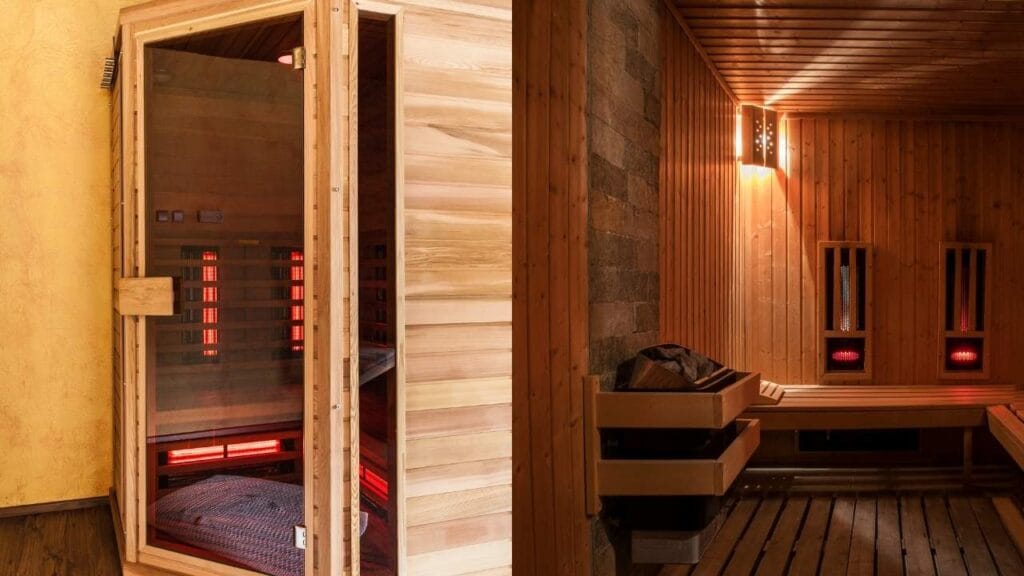This article has been medically reviewed by doctors to ensure it provides accurate, reliable, and up-to-date health information. We only use credible sources to support our content.
As someone who’s been trying out different saunas for years — infrared, traditional, you name it — I can tell you that sauna therapy has been a game-changer for me, especially with fibromyalgia. After countless sessions, I noticed a real difference, particularly in the areas where the pain presses the hardest. The warmth helped ease my muscles, and overall, I just felt lighter.
That got me thinking: Could there be something to this sauna thing beyond just a temporary relief? So, I dug into some research to see if there’s actual science behind it. Turns out, infrared saunas might have some specific benefits for those of us dealing with fibromyalgia. In this article, I’m going to share what I’ve found, how these saunas work for fibromyalgia, and why you might want to give them a try.
What Exactly is Fibromyalgia?

Fibromyalgia is a long-term condition that causes widespread pain, fatigue, and other symptoms that just don’t seem to go away. If you have it, you know it’s not just about feeling tired or having sore muscles; it’s like your entire body is constantly aching, and even simple tasks can feel overwhelming. On top of the pain, there’s often fatigue, brain fog (sometimes called “fibro fog”), and trouble sleeping.
While the exact cause of fibromyalgia is still a bit of a mystery, doctors believe it’s related to how the brain and nervous system process pain signals. For whatever reason, people with fibromyalgia seem to feel pain more intensely than others, even if there’s no obvious cause.
Managing fibromyalgia can be tough because there’s no single cure, but there are ways to improve your quality of life. That’s why treatments are usually focused on relieving symptoms — like using infrared saunas, for example. The key is finding something that works for your body and lifestyle, whether it’s medication, physical therapy, or alternative therapies like sauna sessions. In this case, infrared saunas may offer some much-needed relief, but we’ll get into that in more detail shortly.
How Can Infrared Saunas Help with Fibromyalgia?
Infrared saunas can help with fibromyalgia by providing deep heat that penetrates into your muscles and tissues, easing pain and stiffness. Unlike traditional saunas that just heat the air around you, infrared saunas use infrared light to warm your body directly, which can be a huge relief for people with fibromyalgia. When the heat reaches deep into your muscles, it helps to relax them, reduce tension, and increase circulation, which can lower the intensity of the pain.
For me, after several sessions, I noticed that those stubborn, hard-to-reach aches in my body weren’t as intense. It’s not an instant fix, but after each session, I felt lighter and a little more comfortable in my own skin. The warmth seems to loosen up everything that feels tight and sore, making it easier to move around afterward.
Besides the physical relief, the mental benefits shouldn’t be overlooked. Infrared saunas help promote relaxation, which is key when you’re managing a condition like fibromyalgia that’s often worsened by stress. The gentle heat can also help improve your sleep, which, as anyone with fibromyalgia knows, is a battle in itself. Better sleep can mean better energy levels and a clearer mind, which makes dealing with daily pain a bit more manageable.
So, the next time you step into an infrared sauna, just know you’re not only giving your muscles a break — you’re giving your mind a bit of peace too. It’s like a reset button for both body and soul.
What Does Science Say About Infrared Saunas for Fibromyalgia?
The science behind infrared saunas and fibromyalgia is evolving, but some studies show promising results. One key study published in the journal Internal Medicine focused on chronic pain patients, including those with fibromyalgia. The results were eye-opening: patients experienced a nearly 70% reduction in pain after their first session in an infrared sauna. This pain relief wasn’t just temporary, either—the reduced pain scores remained low throughout the observation period, suggesting that infrared sauna therapy can have lasting effects.
Another study looked at Waon therapy, a type of infrared heat treatment, for fibromyalgia and chronic fatigue syndrome. After several weeks of regular infrared sauna sessions, participants reported reduced pain, less fatigue, and an overall improvement in mood and quality of life. Interestingly, these benefits weren’t just short-term; they persisted for weeks after the sessions had ended. This suggests that consistent use of infrared saunas could be a long-term tool for managing fibromyalgia symptoms.
Lastly, a study by the American College of Rheumatology had fibromyalgia patients participate in both sauna therapy and underwater exercises to explore the benefits of regular infrared therapy. Over a period of 12 weeks, 44 women underwent thermal treatment, with all reporting a 31-77% reduction in pain by the end of the program. This pain relief remained consistent during the 6-month follow-up. The findings showed improvements in both short-term and long-term pain, as well as in the overall impact of fibromyalgia.
While these studies are promising, it’s important to remember that research on infrared saunas for fibromyalgia is still somewhat limited. What works for one person might not work for another, and more large-scale studies are needed to fully understand the potential benefits. Still, if you’re someone living with fibromyalgia, infrared sauna therapy could be a worthwhile addition to your pain management toolkit—especially when combined with other treatments.
Are Infrared Saunas Safe for People with Fibromyalgia?
Yes, infrared saunas are generally safe for people with fibromyalgia, as long as you follow a few basic precautions. The gentle heat they provide is far less intense than traditional saunas, which makes them a great option for those who are sensitive to extreme temperatures or who experience chronic pain. The lower, more controlled heat is less likely to trigger discomfort, but like with any therapy, it’s important to listen to your body.
From my own experience, I found that shorter sessions worked best in the beginning. I started with around 15 minutes at a lower temperature and gradually built up from there. It’s crucial to stay hydrated before, during, and after your session, as sweating can lead to dehydration more quickly than you might think.
One thing to keep in mind is that while infrared saunas are mostly safe, they may not be suitable for everyone. If you have any pre-existing health conditions, such as heart problems, low blood pressure, or are pregnant, it’s always a good idea to consult with your doctor before diving into regular sauna use. And of course, if you start to feel lightheaded or overheated during a session, it’s perfectly fine to step out early—pushing through discomfort is not recommended.
That said, for most people with fibromyalgia, the benefits of infrared sauna use—like improved circulation, reduced muscle tension, and better relaxation—tend to outweigh any potential risks. Just start slow, keep an eye on how your body reacts, and adjust the frequency and length of your sessions as needed to avoid overdoing it.
Infrared Saunas vs. Traditional Saunas for Fibromyalgia

When it comes to fibromyalgia, infrared saunas tend to be a better option than traditional saunas. The main difference is in how they heat the body. Traditional saunas heat the air around you, which can feel intense and sometimes overwhelming. For someone with fibromyalgia, that level of heat can be too much, potentially causing discomfort or even triggering symptoms.
Infrared saunas, on the other hand, use infrared light to heat your body directly without heating the surrounding air as much. The result is a much gentler heat that penetrates deeper into your muscles and tissues, which is ideal for relieving the pain and stiffness associated with fibromyalgia. For me, the difference was clear: I could stay in an infrared sauna longer, and the heat felt more manageable, especially on days when my pain was worse.
Another advantage of infrared saunas is the ability to customize the temperature. With traditional saunas, the heat can get pretty intense, often reaching up to 80°C (176°F) or higher. Infrared saunas, however, allow you to set a lower, more tolerable temperature (typically between 45°C to 60°C), making the experience much more comfortable. This lower heat also allows for longer sessions without feeling drained afterward, which is a big plus when managing chronic fatigue.
So, while both types of saunas offer relaxation and detox benefits, infrared saunas are typically the better choice for people with fibromyalgia. They provide a more tolerable heat and deeper relief for muscle and joint pain without the overwhelming intensity of traditional saunas. If you’re looking for a gentler, more effective way to manage your fibromyalgia symptoms, infrared saunas are likely the way to go.
How Often Should You Use Infrared Saunas for Fibromyalgia?
It’s generally recommended to use infrared saunas 2-3 times per week if you’re dealing with fibromyalgia. This gives your body enough time to benefit from the heat therapy without overdoing it. In my own routine, I found that spacing out my sessions allowed me to fully recover and avoid feeling drained. While it’s tempting to use the sauna every day (especially if you’re enjoying the relief), it’s important to start slow and listen to your body.
When beginning, shorter sessions of about 15-20 minutes are usually best. Over time, as your body adapts, you can gradually increase the duration to around 30 minutes or even a bit longer, depending on how comfortable you feel. The key is to avoid pushing your limits—if you feel lightheaded or too hot, it’s perfectly fine to step out early.
The regularity of sauna sessions can help maintain the benefits you experience, like reduced muscle tension and overall pain relief. However, if you’re new to infrared saunas, it’s wise to consult with your healthcare provider first to determine the recommended sauna duration based on your specific health needs.
Remember, fibromyalgia affects everyone differently, so you may need to tweak your schedule depending on how your body reacts. Start slow, take note of how you feel after each session, and adjust your routine accordingly.
Final Thoughts: Is Infrared Sauna Therapy Worth Trying for Fibromyalgia?
Infrared sauna therapy is definitely worth considering if you’re looking for a natural, non-invasive way to relieve fibromyalgia symptoms. The deep heat helps ease muscle pain, improve circulation, and promote relaxation — all things that can make a real difference when dealing with chronic pain. From my own experience, I’ve found it to be a helpful tool in managing the daily discomfort of fibromyalgia. That said, results can vary from person to person, so consistency and patience are key.
It’s important to remember that while infrared saunas can provide relief, they’re not a cure. For the best results, it’s often helpful to combine sauna sessions with other treatments like gentle exercise, physical therapy, or medication. And of course, if you’re new to saunas, it’s a good idea to consult a healthcare professional before jumping in, especially to determine the right duration for your condition.
In the end, infrared saunas can offer a safe, effective way to help manage fibromyalgia symptoms, making them a solid option to explore if you’re searching for additional pain relief.




